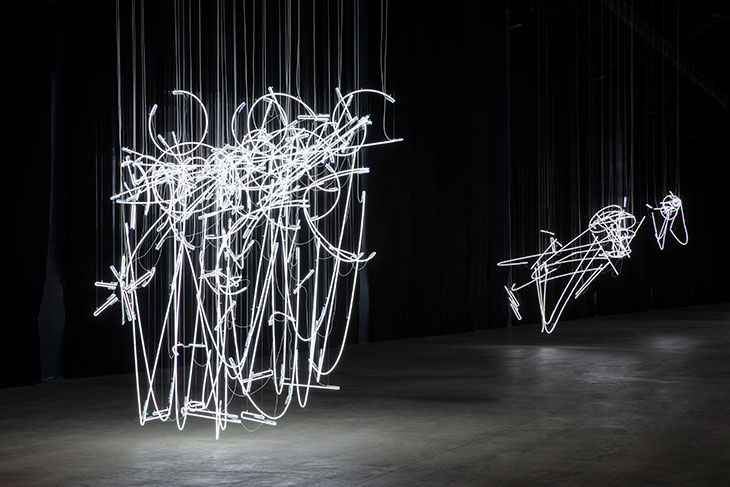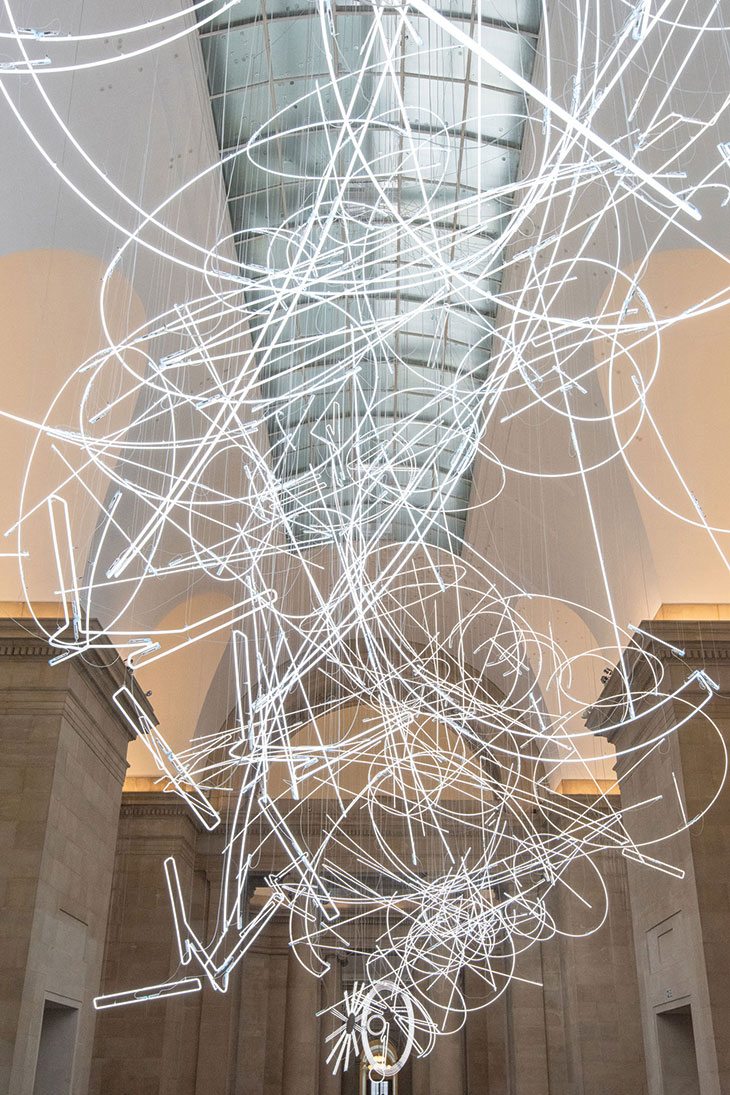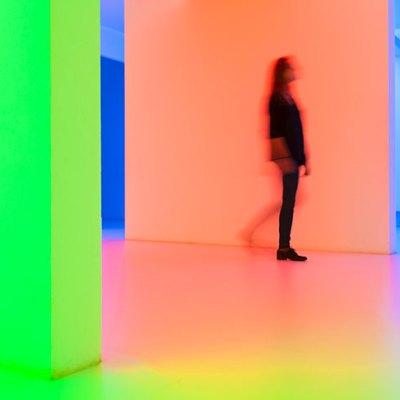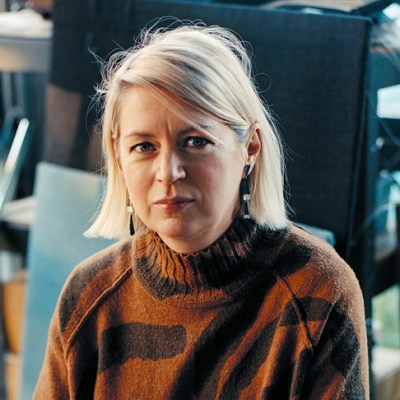Cerith Wyn Evans has filled the Pirelli HangarBicocca in Milan with his large-scale neon sculptures and other installations. He talks to Gabrielle Schwarz about his interest in music and the complicated influence of Marcel Duchamp
This exhibition features works ranging from the 1990s to the present day. What has it been like installing them alongside one another in the cavernous space of the Pirelli HangarBicocca?
Well, this has been the real challenge of the exhibition – realising that it gave me the opportunity to create an occasion. It’s more like staging something, it’s almost theatrical. You can make an event out of the presence of a number of things which have emerged over a period of years, that have a certain unity, if only formally, emerging from a sort of attenuated palette of materials. The majority of the neon works, even though they’re at different scales, come from the same place. They’re literally manufactured by the same people, and they are almost uniformly in the same colour temperature, 6500 kelvin, and various different diameters of glass tubes, from 8mm up to 15mm. So it’s possible to ease the passage and the conversation between various different pieces. Although it feels like such a trawl of different things from different periods, the vast majority of the show – I’d say 80 per cent – comes from the last two years.
Neon Forms (After Noh) (2015–19), Cerith Wyn Evans. Installation view of ‘Cerith Wyn Evans: “…the Illuminating Gas”’ at Pirelli HangarBicocca, Milan, 2019. Photo: Agostino Osio. Courtesy the artist; White Cube; Marian Goodman Gallery, New York, Paris and London; and Pirelli HangarBicocca

You started your career working in film. Do you think there is something cinematic about your recent work?
A lot of my work tries to interrogate optics – to somehow disintegrate the scientific model of optics. I think if you take a book on physics, a book on optics, a book on musical notation, a book on choreology, a book on yoga, and run their diagrams through each other, you end up with some of the forms that are the basis, conceptually and formally, for many of the works in this exhibition.
People consider things to be cinematic if they seem to fall under the rubric of certain kinds of aesthetics, that are broadly associated with the stereotypical scopic regimes that are considered to be cinematic, and that’s largely to do with formats. Given that we’re living through a technological revolution that’s exploding these formats, and breaking down these hierarchical structures, we’re entering into a space which probably hasn’t been explored by artists of the last 100 years, since modernism and two world wars got in the way, and rampant capitalism commodified everything. I think, perhaps, I’m looking through the lens that Duchamp picked up about 100 years ago, when he started looking at things like the fourth dimension and the tesseract.
References to Duchamp run throughout your work. How would you describe his influence on you?
So much has been written on Duchamp – Duchamp is a language, is a territory, is a geography, is a continent, is many, many things, to many people, and he has been used to promote a whole swathe of different positions and ideas. I’m like so many other people who have been caught up in the allure that Duchamp – as an alchemist, as a magician, if you like – was able to cast across things, and in the anxiety that he was able to introduce to the reception of something like the object, and his interrogation of use-value within the art system. [I’m also drawn to] his lightness of touch and his play on words, and his refusal to somehow be cornered and be made to represent a kind of… for want of a better term, masculinity.
Installation view of Cerith Wyn Evans’s Forms in Space…by Light (in Time), commissioned by and first shown at Tate Britain, London, in 2017. Photo: Joe Humphreys/© Tate, London 2018; courtesy White Cube; © Cerith Wyn Evans

What can you tell us about the new works you created for this show?
There are some, although they don’t really appear as new works. I wanted to produce them in order to shoehorn the existing works – one of the big pieces was the commission for the Duveen Galleries at Tate Britain [in 2017] – into a relationship to the building [in Milan]. I wanted to produce something that came out of the Tate piece to shake hands with the rest of the HangarBicocca building – especially since we’re on the verge of falling off the edge of the cliff into Brexit.
I think of the new works as a kind of coda – like something you would add to the end – because I wanted to ask: what would we find at the end? Would we find the present, the here and now? To a certain extent, it’s composed of a kind of reprise, whereby some of the leitmotifs, the themes, are resolved. You have it in one of the great masterpieces, for me: Mantra, the piano duet by Karlheinz Stockhausen. Stockhausen is easily as big an influence as Duchamp in this exhibition. Perhaps this also brings us close to the notion of there being an appeal on my part to extend across media and engage with architects and musicians, all people who are interested in extending an experiment socially, politically, emotionally, psychologically.
There’s also the little exit sign [TIX3 (1994)], the oldest work in the show, which also deals, on a comedic level, with beginnings and endings. This exit sign came from being accidentally locked out of a cinema in Leicester Square in the ’80s. I didn’t want to go through the cinema in order to walk out of the film. I went through the exit doors and I realised that the doors on to the street were bolted, so I had to sit and watch the rest of the film from a position where the only thing I could see was a back-to-front exit sign.
Mantra (2016), Cerith Wyn Evans. Photo: George Darrell; courtesy White Cube; © Cerith Wyn Evans

Where does your interest in playing with language come from?
It’s difficult to draw that out without feeling as if I’m somehow betraying something which is innate. Nor do I feel that I should be saying the work speaks for itself, though. When I was a student at Saint Martins, in the late 1970s, on the Sculpture A course there, this was something that I felt was a real affront to my identity, my being. When people would say, ‘Why are you labelling it up with all these different things, and why are all these little meta-narratives and little loops and little feedbacks and little things emerging that throw you off?’ They said, ‘Let’s call a spade a spade’ – well, Magritte never did that, and Marcel Broodthaers or Elaine Sturtevant never did that. Many of the artists that I hold in the highest regard always had doubts in that respect. I find a certain space of genuine integrity in the concept of doubting the material world, of doubting perception.
‘Cerith Wyn Evans: “…the Illuminating Gas”’ is at Pirelli HangarBicocca, Milan, until 26 July 2020 (exhibition dates extended).
From the November 2019 issue of Apollo. Preview and subscribe here.



